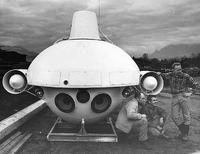Subsea Technology
SUBSEA TECHNOLOGY is an industry in which BC is a world leader. While the extreme depths of local waters limits scuba diving, the deep coastal FJORDS provide excellent places to develop and test new equipment. Areas of development include both manned and robotic submersibles. Robotic submersibles are of 2 types: Remotely Operated Vehicles (ROVs), where the submersible is connected to the surface operator by a tether or umbilical cable, and Autonomously Operated Underwater Vehicles (AUVs), where the submersible operates without a tether, roaming the sea as long as its power supply lasts. Manned submersibles are primarily small, 1- to 3-person submarines called Driver Operated Vehicles (DOVs). Another type of manned subsea equipment is Phil NUYTTEN's Newtsuit, an example of an atmospheric diving suit (ADS). Other notable subsea technology developed in BC includes underwater sonar, survey, navigation and communication systems, Arctic diving systems, sea-floor oil production systems and tourist submarines.
The requirements of the off-shore oil industry in the mid-1970s inspired many BC companies to develop innovative and multi-use vehicles, hardware and software, as well as techniques for subsea work (see also OIL AND GAS INDUSTRY). International Hydrodynamics Co Ltd (HYCO), founded by Al TRICE, Don Sorte and Mack Thompson, scored the first major success with the 3-person Pisces class non-military submarine launched in 1966. Many key figures in BC's subsea industry got their start at HYCO. Others working for John Horton of Horton Maritime went on to pursue acoustic research, including positioning and communications systems. By 1999 the largest subsea company in the province was International Submarine Engineering Ltd (ISE) in PORT MOODY. Founded in 1974 by James McFARLANE, ISE is a world leader in the design and integration of ROVs, AUVs and terrestrial robotics. In total, more than 100 BC companies are involved in some facet of subsea technology.
The federal government began its own subsea research when it set up the Institute of Ocean Sciences (IOS) at Patricia Bay on VANCOUVER ISLAND. Oceanographic studies, as well as subsea technology facilities, are available at 3 of BC's universities (see also OCEANOGRAPHY). BC RESEARCH INC at UBC has the province's only large test tank for hydrographic testing. The underwater research lab at SFU has developed a number of mini-ROV and AUV submersibles. And the UNIV OF VICTORIA maintains connections with the IOS at Patricia Bay in SAANICH INLET.
by Vickie Jensen

